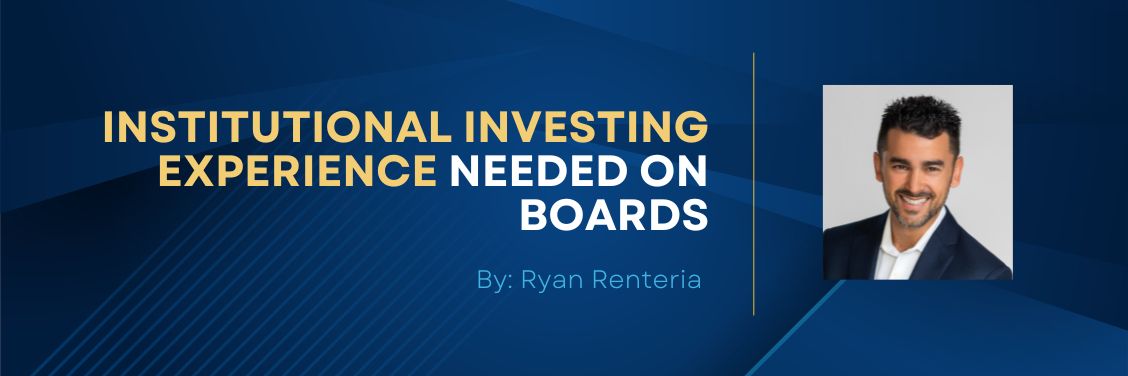Institutional Investing Experience Needed on Boards

Those with an investing background can help in the areas of strategy, capital allocation and the CEO relationship.
Board diversity is all the rage and rightly so. Yet, these efforts are falling short in areas that aren’t so obvious.
Demographic variation doesn’t always achieve the vital cognitive diversity boards need. One element of cognitive diversity is quite underappreciated in board composition: diversity of human capital and professional experience.
“Non-C-Suite” is one of the fastest growing groups of directors. Yet, those with unique human capital experience from outside of the C-suite remain far too underrepresented. One type of professional experience is particularly suited to help boards maximize long-term shareholder value: institutional investing.
A board has three key duties to ensure its company delivers shareholders a strong long-term return on investment. Let’s examine each of these duties and how institutional investing experience is an ideal fit to help boards deliver on them.
Strategy. Seventy percent of public companies whose revenues stall lose more than half of their market capitalization. Additional research attributes the primary reason to poor strategic decisions.
Some argue that directors should be utilized more in the strategy development process. At the very least, one critical board duty is to provide seasoned guidance on the CEO’s long-term strategic assessment, plans and decisions.
- Institutional investors analyze thousands of companies’ strategic plans to assess odds of success. They have seen a wide range of strategic visions and decisions succeed and fail. Hence, they can bring boards a unique perspective on best practices and pitfalls to avoid in the realm of strategy.
- No board can provide sound feedback on a strategy without a deep understanding of its financial implications. The core elements of strategic finance — analyzing the financial plan for long-term growth, making data-driven financial decisions, and adapting as evidence builds — are precisely what institutional investors do for a living.
- Great strategies can fail to maximize shareholder value due to poor investor communication. When I was an institutional investor, CEOs would ask me why their stock price reacted unfavorably to their strategic plans. Sometimes they set stretch long-term earnings targets. The market would cut their multiple (and keep it subdued) in fear of earnings misses along the way. At other times, they weren’t clear about how their strategic initiatives would bolster ROIC. Institutional investors can help communicate strategic and financial plans to stakeholders.
Capital allocation. Another vital board duty is assessing capital allocation options. Boards would benefit from an investor’s financial rigor when comparing all options on risk-adjusted ROIC versus cost of capital.
- M&A. Seventy to ninety percent of mergers and acquisitions fail per Harvard Business Review’s assessment of many studies. Institutional investors have seen thousands of M&A deals fail. Common reasons include optimistic synergies, poor cultural fit, and integration issues. Often, companies fall victim to recency bias and pay peak multiples on peak margins. Investors can bring this wealth of experience to boardrooms to ask the right questions about proposed M&A deals.
- Organic growth. As businesses mature, management may justify capital expenditure using unrealistic ROIC forecasts. Institutional investors have the financial expertise to challenge these assumptions. How much capital can the company reinvest before it sees diminishing returns?
- Buybacks. Companies often “buy high” by accelerating share repurchases after large price run-ups. They sometimes “sell low” by not executing repurchases during downturns when the stock is below intrinsic value. Investors are successful by overcoming these cognitive biases and doing the opposite. They can help boards do the same.
- Debt paydown. We’ve already seen a large spike in the number of zombie companies struggling to service high debt loads. If the economy enters a recession in the coming year, this problem will only worsen. Many will wish they were more realistic about “downside EBITDA” when they determined debt levels that wouldn’t trip covenants. Investors are trained in modeling downside scenarios and can help boards ensure prudent debt levels.
The CEO. According to Warren Buffett, “The most important job of a board of directors is to ensure that the right CEO is in place.” Here are a couple of practices that should be kept in mind to ensure success for the CEO position.
- Evaluating CEO candidates. Succession planning should begin within months of a new CEO’s tenure. Directors should observe internal candidates on the job. Solicit feedback from colleagues, customers, and partners. How strong is their leadership, talent development, execution, decision-making and adaptability? Investors conduct similar diligence checks across all constituents to evaluate management teams before investing. They can bring that unique skill set to boards.
- Ensuring the CEO is delivering by supporting them. Directors should serve as a sounding board to CEOs on many topics. Are the financial projections realistic? Are they appreciating all the important risks in their analysis? Are cognitive biases influencing their decisions, risking a repeat of a prior mistake? Investors are experienced in asking their colleagues tough questions and uniting the room on the best decision.
As a Latino who has learned so much from people of all demographic backgrounds, I champion these board diversity efforts. Diversity of human capital and professional experience is also a massive opportunity. Institutional investing is one underappreciated experience particularly suited to add value to boards.
This article originally appeared on Private Company Director website. It is reprinted with permission from MLR Media.

ABOUT RYAN RENTERIA
Ryan Renteria is an advisory board member of The Private Placement Group, founder of CEO coaching firm Stretch Five and author of Lead Without Burnout: Growth with Less Stress for You and Your Team. He previously worked for Goldman Sachs and as an institutional investor for large funds. He can be reached at [email protected].
Disclaimer: The views and opinions expressed in this blog are solely those of the authors providing them and do not necessarily reflect the views or positions of the Private Directors Association, its members, affiliates, or employees.
